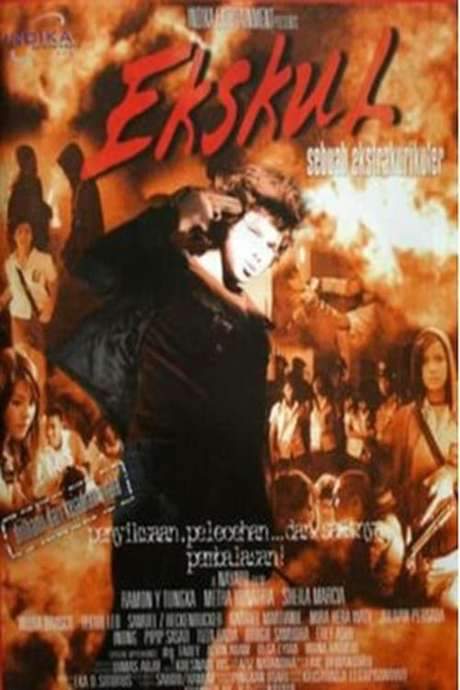
Ekskul
Year: 2006
Runtime: 109 mins
Language: Indonesian
Director: Nayato Fio Nuala
Joshua is a tormented high‑schooler constantly bullied by Mike’s gang—hung from a fence, shoved into a toilet—and subjected to physical abuse at home. Mocked by Katie, who dates Mike’s friend, he becomes isolated, confiding only in Shabina, the police captain’s daughter. Desperate for vengeance, he builds a homemade pistol and takes six classmates, including Mike and Katie, hostage inside the school.
Warning: spoilers below!
Haven’t seen Ekskul yet? This summary contains major spoilers. Bookmark the page, watch the movie, and come back for the full breakdown. If you're ready, scroll on and relive the story!
Ekskul (2006) – Full Plot Summary & Ending Explained
Read the complete plot breakdown of Ekskul (2006), including all key story events, major twists, and the ending explained in detail. Discover what really happened—and what it all means.
The pre-title scene opens with a tense image: Joshua Ramon Y. Tungka sits in a psychiatrist’s office, stubbornly resisting the shrink’s attempts at persuasion. The exchange slips into a few awkward, slightly jokey lines about transsexual brothers, setting a offbeat, uneasy tone before the title card finally appears.
Cut to a sprawling police presence around Joshua’s school, a dramatic web of officers, SWAT teams, and snipers ready for action. Joshua has bought a gun and has locked himself inside the school counselor’s office with six students as hostages. The calm of the corridors is broken by radio chatter, tense glances, and a stark, high-stakes standoff that dominates the film’s momentum.
The bulk of the narrative unfolds through flashbacks that reveal the events leading up to the crisis. Joshua’s sense of isolation is laid bare as he recalls brutal beatings from a school gang and suffering at the hands of his own father, who is present in the memory as a harsh, controlling force. He is pinned down at the school gate, his collar gripped tightly, and his face is forced into humiliating degradation, each memory amplifying the hurt that fuels his choices in the present crisis. The flashbacks also touch on his brief romance with Cathy Metha Yunatria, a popular student who sees something human in him, and Sabina Sheila Marcia, a beautiful yet introverted girl who offers quiet sympathy.
Within these recollections, the film sketches Joshua’s complex relationships. There is the supportive, practical presence of Mrs. Miranda Olga Lydia, the school counselor who tries to bridge understanding with the increasingly volatile student, while Joshua’s parents, including his father Boogie Samudra (the father who embodies a painful part of his past), watch with a mix of concern and helplessness.
As negotiations unfold, the authorities hope to persuade Joshua to release the hostages. The dialogue is punctuated by Joshua’s raw expressions of frustration, broadcast to the press and viewers alike, painting a portrait of a young man pushed to the edge by years of torment. The tension intensifies when he begins to loosen the grip on his captives, first freeing the female hostages—Cathy among them—before deciding to keep the male hostages, including those who had tormented him for so long.
In a chilling sequence that blends cruelty with a perverse sense of justice, Joshua forces the male captives to confront the consequences of their actions. He compels them to witness the humiliation of their strongest leader by shoving his head into a toilet, then subjects Jerry Teguh Leo to a fearsome display of power from the school roof. It’s a brutal, almost ritual moment that underscores Joshua’s sense of reprisal.
Mrs. Miranda pleads for the release of all hostages, urging mercy and a chance to end the crisis without more bloodshed. Joshua remains defiant, insisting that those who harmed him deserve to die. Yet a critical breakthrough arises when the police arrest the man who sold Joshua his gun and learn something that could alter the course of the situation: Joshua apparently has only one bullet left. Mrs. Miranda uses this information as leverage to press for surrender, hoping for a peaceful conclusion, though Joshua’s real plan remains shrouded in ambiguity.
As officers position themselves to sweep the roof and secure the scene, Joshua makes a final, devastating choice. In a moment that dissolves the boundary between desperation and resolve, he points the gun at his own head and takes his own life, ending the siege in a stark, tragic finale.
It’s judgement time.
Last Updated: October 09, 2025 at 16:45
Unlock the Full Story of Ekskul
Don't stop at just watching — explore Ekskul in full detail. From the complete plot summary and scene-by-scene timeline to character breakdowns, thematic analysis, and a deep dive into the ending — every page helps you truly understand what Ekskul is all about. Plus, discover what's next after the movie.
Ekskul Timeline
Track the full timeline of Ekskul with every major event arranged chronologically. Perfect for decoding non-linear storytelling, flashbacks, or parallel narratives with a clear scene-by-scene breakdown.

Characters, Settings & Themes in Ekskul
Discover the characters, locations, and core themes that shape Ekskul. Get insights into symbolic elements, setting significance, and deeper narrative meaning — ideal for thematic analysis and movie breakdowns.



